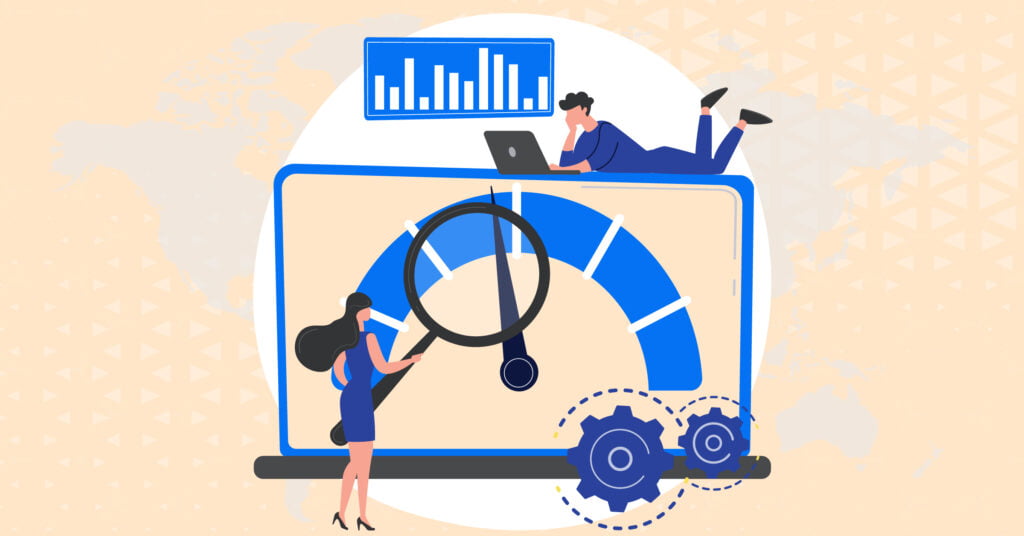
| Summary: Users often prefer software apps that are easy to use and show high performance. Besides, there has been a massive shift in the software industry. As a result, the app has to ensure it can be stable under multiple conditions. But how can we achieve this? Yes, it is through performance testing. So, this blog will help you learn the benefits, types, and tools for performance testing. Keep scrolling for more. |
Most industries use software apps to meet their business goals and needs. Therefore, they must have the ability to perform more than one task. That is why we need to run performance testing for our app. Performance testing life cycle ensures your app behaves as expected under the workload. You can evaluate the app’s response, behavior, stability, and scalability.
In this article, we will walk you through the following topics to help you get in-depth knowledge on performance testing:
- What is performance testing?
- Benefits of performance testing
- Steps in the performance test life cycle
- Different types of performance testing
So, let us start.
What is performance testing?
Performance testing is a non-functional software testing that checks the efficiency of the app rather than for bugs. In other words, it ensures the app’s behavior is intact without any bottlenecks. Besides, it examines the high volume data flow through the app and measures its quality. As a result, you can scale up your apps as your business grows.
The performance testing life cycle includes different phases. It analyzes your app to achieve standard performance. Therefore, it involves steps like examining the non-functional area of the app to test results. Besides, it helps you plan the test strategy, design the test flow, and execute it to achieve the desired outcome.
Moreover, you can hire the finest service providers if you need performance testing services. They have highly skilled and certified developers to build your app that matches your needs. Further, they offer futuristic and cutting-edge tools that maintain your app’s performance. So, look for the best software testing service providers and get the solutions for your demands.
So, when you test your app for its performance, ensure your app has the following attributes:
- Stability: High stability means your app is stable under varying workloads.
- Page Speed: Check your app to respond quickly to different tasks.
- Scalability: Ensure your software app can handle the high volume of user loads.
Now, let us explore the benefits of the performance testing life cycle for software apps.
What are the benefits of performance testing?
The performance testing guarantees an app that is high-performing with a seamless workflow. In other words, your app can handle all sorts of tasks without glitches. So, now we will help you know why performance testing is critical for SDLC.
The following are the benefits of performance testing:
- Ensure Feature Functionality:
The benefit of performance testing is that it tests the features of the software app. It measures the performance of each element in the software app and analyzes if it meets the required needs and demands. As a result, you can make decisions for your software setup through performance testing.
- Enhance User Satisfaction:
Performance testing life cycle allows you to know how your customers react to the software app. As a result, you can analyze the issues and fix them before it reaches the end users. Hence, you can deliver an app that meets the needs of the customers and satisfies them.
- Improve Efficiency:
Since the performance testing examines the app’s behavior is intact, it enhances the efficiency of your app. In other words, it helps fulfill your needs and keep your business on track.
- Remove Discrepancies:
Before releasing it to the end users, the developers run performance tests to resolve issues. As a result, you can deliver an app with no bottlenecks or differences.
- Handle Scalability and Stability:
With the help of a performance testing life cycle, you can monitor elements in the software under varying loads. Besides, examining these components will enhance the performance of your app. As a result, it gives you data that helps you improve the scalability of your app.
- Improve App Load Capacity:
When your business grows, you hit a high level of users. As a result, you need your software to handle the user loads. However, with the help of performance testing, you can scale up your software app and cope with high data volume.
What are the steps in the performance test life cycle?
The performance testing life cycle goes in parallel with the software development life cycle. Besides, it fills the gaps in the app and achieves the expected result. As a result, you can deliver an app that is highly performing and responsive.
So, given below are the different phases in the performance testing process:
Step 1- Analyze Non-Functional Needs:
The first step is to examine the non-functional requirements of your app. Besides, it helps you understand the eligibility of each component in your app according to the business and customer needs.
Tasks Involved:
- Study the Application Under Test (AUT) architecture.
- Identify and understand the critical test scenarios.
- Examine the user interface of the app.
- Data flows through the app.
Step 2- Performance Testing Strategy:
During this phase in the performance testing life cycle, you can make a proper plan to approach the test. In other words, you can build the test strategy for your app. Besides, you can decide on the testing tools and methods to run the performance test.
Tasks Involved:
- Plan and examine test strategy.
- Define the scope and out-scope of the test.
- Prepare and review risk management.
Step 3- Design the Test:
This step involves generating test scripts in the setup environment using testing tools. Besides, these test scripts undergo unit tests for further improvement.
Tasks Involved:
- Test the scripts.
- Designing test measures and transactions.
- Conduct unit testing.
- Create data parameters.
Step 4- Execution:
The test engineers carry out this step by designing test scenarios based on the predefined workload capacity needs. Besides, this phase in the performance testing life cycle involves loading the system with users.
Tasks Involved:
- Design and execute test scripts.
- Monitor the test script execution.
- Load the test scripts.
- Gather the log files.
Step 5- Result Analysis:
Again the test engineers examine and study the log files to understand further needs. As a result, they can take action accordingly.
Tasks Involved:
- Document the test and report the analysis.
- Review the result.
Step 6- Feedback and Recommendation:
Giving proper feedback is the last step in the performance testing life cycle. The experienced testers provide recommendations to bring out the best app to the real world.
Tasks Involved:
- Compare outcomes with past results and standards.
- Prepare an overall test report.
What are the types of performance testing?
- Load testing:
Load testing involves testing the software app under varying user loads. In other words, it checks if the app works seamlessly under heavy traffic and an increased number of users. So, here the load refers to the number of users using the app within a specified time. As a result, you can eliminate performance bottlenecks in your app before it reaches the real world.
- Stress testing:
After developing the software app, the developers expose the app to heavy workloads through a performance testing life cycle. It helps them know the app’s load capacity and its breaking point. Besides, the developers push the app to its load limits to check which area of the app fails.
- Endurance testing:
Endurance tests examine the app’s ability to handle workloads for long periods. So, the developers apply varying loads to the app over a prolonged time to see how it reacts and withstands the pressure.
- Spike testing:
Spike testing involves testing the app to see how it reacts to a sudden increase in user loads. So, this type of testing is to check if the system fails to manage the sudden spike in user loads.
- Volume testing:
With this type of testing in the performance testing life cycle, you expose your app to a high volume of data to know its response time and performance. As a result, you can spot the issues to analyze its ability to perform under high data volume.
- Scalability testing:
Scalability testing checks how the app can manage under heavy loads. In other words, you can assess the app’s effectiveness when it gets scaled up to handle rising loads. So, it helps the developer understand the app’s response time and network usage.
Conclusion
Performance testing life cycle helps the software app to have high performance before it reaches the market. Besides, it checks how the app behaves under varying workloads and situations. Therefore, doing the performance test helps get more users to use your app and ensures that it satisfies their demands. As a result, your business can meet the desired needs and goals. So, look for experienced service providers and get high-performing and quality apps through performance tests.
Want to discover more stories and insights? Visit our blog for the latest updates and expert articles.
References:
Performance Testing – Types, Tools, Goals and Life Cycle – OpenXcell
Performance Testing Life Cycle : All You Need To Know About Testing Phases – Edureka
Performance Testing Life Cycle | Different Types Of Performance Testing (educba.com)
Performance Testing Life Cycle | PTLC | STLC | SDLC (perfmatrix.com)







Leave a Reply